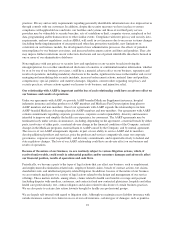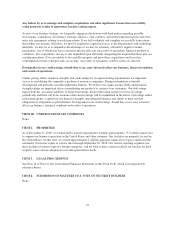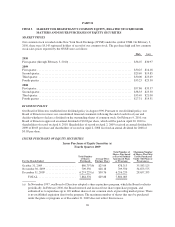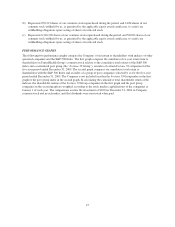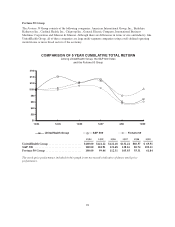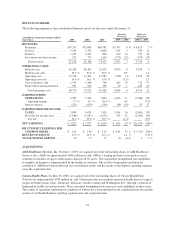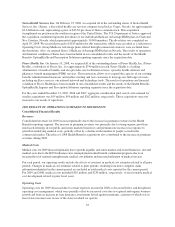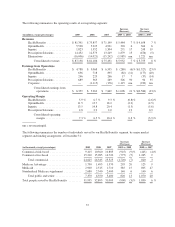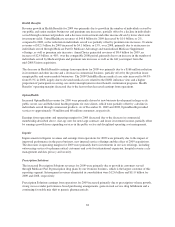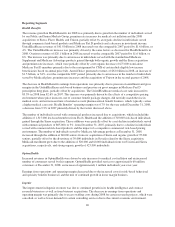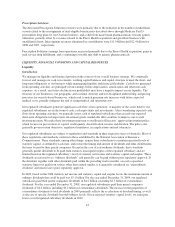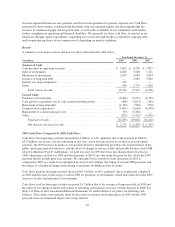United Healthcare 2009 Annual Report Download - page 34
Download and view the complete annual report
Please find page 34 of the 2009 United Healthcare annual report below. You can navigate through the pages in the report by either clicking on the pages listed below, or by using the keyword search tool below to find specific information within the annual report.Medical costs include estimates of our obligations for medical care services rendered on behalf of insured
consumers for which we neither have received nor processed claims, and for liabilities for physician, hospital and
other medical cost disputes. In every reporting period, our operating results include the effects of more
completely developed medical costs payable estimates associated with previously reported periods.
Our medical care ratio, calculated as medical costs as a percentage of premium revenues, reflects the
combination of pricing, benefit designs, consumer health care utilization and comprehensive care facilitation
efforts. We seek to sustain a stable medical care ratio for an equivalent mix of business, however, changes in
business mix, such as expanding participation in comparatively higher medical care ratio government-sponsored
public sector programs, will change the dynamics of our results.
Operating Costs. Operating costs are primarily comprised of costs related to employee compensation and
benefits, agent and broker commissions, premium taxes and assessments, professional fees, advertising and
occupancy costs.
Cash Flows
We generate cash primarily from premiums, service revenues and investment income, as well as proceeds from
the sale or maturity of our investments. Our primary uses of cash are for payments of medical claims, purchases
of investments, common stock repurchases and payments on long-term debt. For more information on our cash
flows, see “Liquidity” below.
Business Trends
Our businesses participate in the U.S. health economy, which comprises approximately 17% of U.S. gross
domestic product and which has grown consistently for many years. We expect overall spending on health care in
the U.S. to continue to rise in the future, based on inflation, demographic trends in the U.S. population and
national interest in health and well-being. The rate of market growth may be affected by a variety of factors,
including macro-economic conditions and proposed health care reforms, which could also impact our results of
operations.
Adverse Economic Conditions. The current U.S. recessionary economic environment has impacted demand for
some of our products and services. For example, decreases in employment have reduced the number of workers
and dependants offered health care benefits by our employer customers, putting pressure on top line growth for
our UnitedHealthcare and OptumHealth businesses. This workplace attrition contributed more than half of the
7% decrease in UnitedHealthcare’s commercial membership during 2009, and this attrition trend is expected to
continue at a generally elevated level until national employment stabilizes. In contrast, our AmeriChoice business
is experiencing growth in its state Medicaid offerings as employment rates fall. If the recessionary economic
environment continues for a prolonged period, federal and state governments may decrease funding for various
health care government programs in which we participate and/or impose new or higher levels of taxes or
assessments. Our revenues are also impacted by U.S. monetary and fiscal policy. In response to recessionary
conditions, the U.S. Federal Reserve has maintained the target federal funds rate at a range of zero to 25 basis
points. Changes in federal monetary policy have reduced the level of investment income received on our
portfolio on a year-over-year basis.
In total, we believe that economic recessions will slow our revenue growth rate and could impact our operating
profitability. We also believe that government funding pressure, coupled with recessionary economic conditions,
will impact the financial positions of hospitals, physicians and other care providers and could therefore increase
medical cost trends experienced by our businesses. For additional discussions regarding how the adverse
economic conditions could affect our business, see Item 1A, “Risk Factors.”
32


